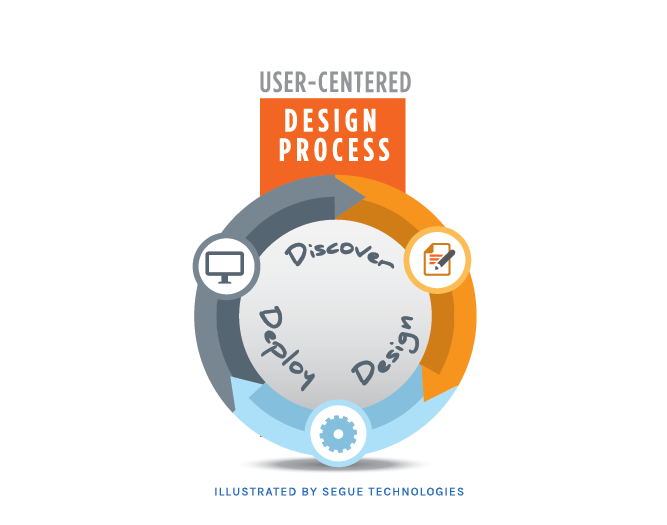
Segue practices an iterative design process that lends itself to a user-centered design (UCD) approach to deliver engaging solutions that foster a positive user experience. The process is broken down into three phases: discovery, design, and deployment. It can be tailored to meet client requirements and budgets.
Discovery Phase
The Discovery phase is a data collection and vetting process, which sets the path for the design approach. At this stage, the goal is to learn about the users’ mental model and how they expect the website or application to function. This information identifies the critical tasks and goals of the website based on the users’ needs, which will drive the design solution.
Depending on budget and time constraints, users can be interviewed, surveyed, attend focus groups, or participate in contextual interviews. A site analysis is also completed using a variety of traditional and lean UX methods. Heuristic and expert reviews, usability tests, or data scrubs on web logs are just some of the methods that can be used to collect information about the pain-points and areas for focus.
Once this information is compiled, Segue identifies the critical tasks and high-level goals for the website. Personas and scenarios are then developed to represent a cross section of the target audience. These personas are constantly evaluated again during the design review process to ensure we are meeting the needs of the users.
Design Phase
During the Design phase, Segue determines how the site content should be organized based on the data collected during the evaluations. A content inventory takes place for pre-existing sites and applications, and the card sorting exercise results (a process involving sorting a series of cards, each labeled with a piece of content or functionality, into groups that make sense to users) will indicate where users feel content belongs and how it should be grouped on the site. From this information we can derive the users’ ideal structure for the information architecture, developing a high-level site map of the website.
Low fidelity wireframes are mocked up and tested with walkthroughs or click-through testing exercises. Designs are adjusted based on user feedback, and followed by another round of testing to validate that the changes improved the user experience further.
Once the layout has been confirmed, a hi-fidelity prototype is developed and used for validation and affordance testing. Prototypes can be online or paper formats. After testing takes place, feedback is incorporated again into the overall design. At this point the design specification documents and the prototypes are ready for development.
Deployment Phase
The Deployment phase takes the website live, and is tested to ensure all objectives have been met. Surveys can be distributed to collect data on overall satisfaction of the site, and field studies or interviews can determine if all of the criteria have been addressed. Once this happens, the UCD methodology can be repeated for new phases of development on the same product.
Continuing with an iterative process will conclude every phase of the project lifecycle with a successfully developed, user-friendly product.